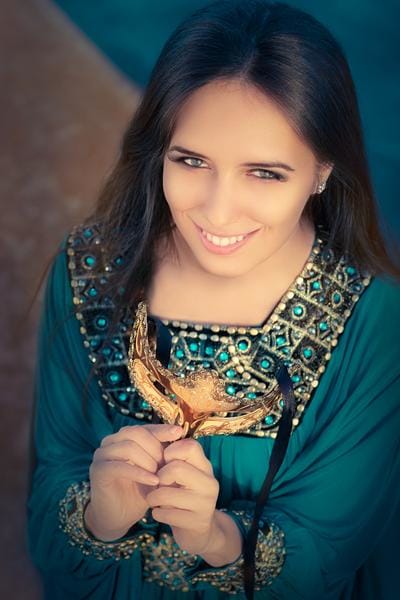Worn for centuries by the Arab populations, the caftan is democratizing and becoming more and more universal. This traditional tunic is now carried in various regions around the world and even becomes a trendy fashion accessory! But do you know the origin and history of the caftan?
Do not hesitate to visit our other articles around the Caftan:
The origin of the caftan
The caftan is an outfit that draws its Origins of Persian civilizations and the Ottoman Empire. Created in 1515 in Tlemcen, this traditional tunic has seized the Middle East following the migration of the Ottoman peoples to the Maghreb.
The geo-historical expansion of Islam has largely contributed to the propagation and progressive transformations of the caftan - also called Takchita - over the centuries. Trade and the arrival of tissues from other countries have allowed the transformation of the old caftan to the one we know today: The Moroccan Caftan.
What is the origin of the caftan? The caftan is resulting from a mixture of culture and civilizations throughout time. It is found by Persian origins, Ottoman and especially Moroccan.
Initially, the caftan (Moroccan Takchita) was intended for sultans and worked families. However, over time, the caftan has democratized and today this traditional dress is now within the reach of any social class. The caftan has become the traditional tunic to wear during marriages, during religious holidays like Ramadan, Eid, etc. daily !

In the past, the Eastern Moroccan Djellaba was used to protect the body of aggression and fight against climatic gaps. Over time, its utility and practicality have been modified to make it aesthetic ready-to-wear.
At the base, the caftans are long, loose, rights or almost flared, without sleeves or hoods. They are open and dotted with buttons and golden ornaments.
However, this traditional modern dress has evolved and adapted to modern centuries. Now, she has other meanings and is a garment Who mixed modesty, seduction and elegance. This is only a few decades that the caftan is perceived as an aesthetic and refined room accessible to all women. Caftans like those made available on Caftan Shop can reach a very high refinement point in their making and be a high quality.
The modernity of the caftan
The modern Moroccan caftan has been able to cross the Moroccan kingdom borders to expand in Europe and in the rest of the world! Nowadays, he shines at the international and ends up in the big fashion shows. Formerly worn by the women of the Maghreb, the caftan is now coated by European women, African or Asian! We find elsewhere Unique creations who mix crops around the world (eg Caftan Kimono).
True trend of recent years, The Caftan Marie Tradition and modernity to perfection.
The caftan is not just a dress. It is a ready-to-wear piece that is easy to lend to changes and innovation! The stylists and creators do not hesitate to revisit the dress by making her An evening clothing like a pajamas to wear at home !
The woman and the caftan
The Takchita is a long dress for women that can be worn not only at home, on a daily basis and when they attend special events.
Often worn with heels considering the length of the cut. The Caftan has experienced an evolution. He is now with luxurious accessories Like jewelry, necklaces and a belt to refine the size.
Did you know that the caftan was initially worn by men? It was only in the 19th century that it was adopted by women and that it becomes almost exclusively feminine.

The Moroccan Caftan
The Takchita is well anchored in the Maghreb culture and more precisely in Moroccan culture. Yet, despite this traditional anchor, the Moroccan caftan is wearing the 4 corners of the world!
Considered to be The most famous caftan in the Arab worldThe Moroccan Caftan is the fruit of the mix of various cultures and refinement centuries.
It exists Different types of caftans. Traditionally, every city in Morocco (Tangier, Casablanca, Marrakech, etc.) has its own style of caftan and embroidery.
The Caftan El Rbati (Rabat)
He made his appearance recently (beginning of the 20th century). It is the most modern caftan. It is characterized by narrow sleeves and a straight cut.
The Caftan El Fassi (Fez)
Fassi Caftans are manufactured from natural silk or velvet. Embroidery in thread or silver come to adorn the neckline, sleeves and shoulders.
This caftan is Very similar to Caftan Meknassi (Meknes).
The Caftan El Chamali (Tetouan)
Andalusian tradition, women make the caftan in a thick velvet with short sleeves. It has the particularity of having buttonholes on the 2 sides, which allows highlight the upper vest.
Moroccan caftan in France
Unlike other countries that have begun to lose their customer identity, Moroccan people are proud to present and wear their caftan around the world. In France, a country known for its cosmopolitanism, the caftan has been a unique place, whether in the Maghreb community as in fashion in general.
Paris has a global influence on trends. Stylists and Haute Couture Houses (Yves Saint Laurent in particular) do not hesitate to draw on this traditional Moroccan dress to present exceptional pieces at prestigious events like Fashion Week.
Beyond this "fashion" scope, many Maghreb women live in France and need caftans for their wedding ceremony, family or religious holidays or to feel comfortable on a daily basis!

To conclude about the origin of the Moroccan caftan
If the Caftan has been able to impose itself in modern society, it is largely thanks to his ability to modernize and Adapt to new clothing codes.
Far from being blurred, the origins of the Caftan are clear and precise. Originally from the Ottoman Empire, this garment has been grabbed by Moroccans and has become a traditional garment of the country.
Over the centuries, the Caftan has been able to travel and impose themselves around the world.
These last years, This Moroccan ready-to-wear is popularized And becomes, beyond a traditional clothing, a dress worn by always more women.







Leave a comment